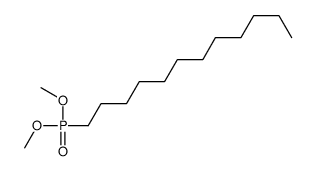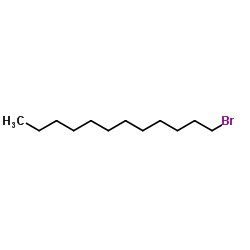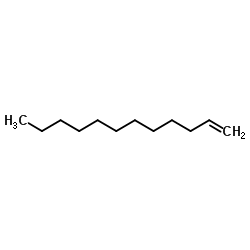正十二烷基磷酸, 99%,Dodecylphosphonic Acid
产品编号:西域试剂-WR139616| CAS NO:5137-70-2| MDL NO:MFCD00015832| 分子式:CH3(CH2)11P(O)(OH)2| 分子量:250.31
本网站销售的所有产品仅用于工业应用或者科学研究等非医疗目的,不可用于人类或动物的临床诊断或者治疗,非药用,非食用,
| 英文名称 | Dodecylphosphonic Acid |
|---|---|
| CAS编号 | 5137-70-2 |
| 产品熔点 | 68-70ºC |
| 产品沸点 | 383.8ºC at 760 mmHg |
| 产品密度 | 1.018 g/cm3 |
| 产品闪点 | 185.9ºC |
| 精确质量 | 250.17000 |
| PSA | 67.34000 |
| LogP | 4.08500 |
| 外观性状 | 固体;White to Almost white powder to crystal |
| 折射率 | 1.462 |
| 稳定性 | 常温常压下稳定 |
| 储存条件 | 避光,阴凉干燥处,密封保存 |
相关文档
化学品安全说明书(MSDS)
下载MSDS质检证书(COA)
相关产品
| 危险品运输编码 | UN3261 |
|---|---|
| 包装等级 | III |
| 海关编码 | 2931900090 |
|
Section 1: Product Identification Chemical Name:n-Dodecylphosphonic acid, min. 97% CAS Registry Number:5137-70-2 Formula:CH3(CH2)11P(O)(OH)2 EINECS Number:225-897-8 Chemical Family:organic phosphonic acid Synonym:1-Dodecanephosphonic acid
Section 2: Composition and Information on Ingredients IngredientCAS NumberPercentACGIH (TWA)OSHA (PEL) Title compound5137-70-2100%no datano data Section 3: Hazards Identification Emergency Overview:Irritating to skin, eyes and respiratory tract. Primary Routes of Exposure:Inhalation, skin, eyes Eye Contact:Dust causes moderate to severe irritation of the eyes. Skin Contact:Causes irritation to the skin Inhalation:Causes irritation to the nose, mucous membranes and respiratory tract Ingestion:No information on the physiological effects of ingestion. May be harmful if swallowed. Acute Health Affects:Irritating to skin, eyes and respiratory tract. Chronic Health Affects:No information available on long-term chronic effects NTP:No IARC:No OSHA:No SECTION 4: First Aid Measures Immediately flush the eyes with copious amounts of water for at least 10-15 minutes. A victim may need Eye Exposure: assistance in keeping their eye lids open. Get immediate medical attention. Wash the affected area with water. Remove contaminated clothes if necessary. Seek medical assistance if Skin Exposure: irritation persists. Remove the victim to fresh air. Closely monitor the victim for signs of respiratory problems, such as difficulty Inhalation: in breathing, coughing, wheezing, or pain. In such cases seek immediate medical assistance. Seek medical attention immediately. Keep the victim calm. Give the victim water (only if conscious). Induce Ingestion: vomiting only if directed by medical personnel. SECTION 5: Fire Fighting Measures Flash Point:no data Autoignition Temperature:no data Explosion Limits:no data Extinguishing Medium:carbon dioxide, dry chemical or foam If this product is involved in a fire, fire fighters should be equipped with a NIOSH approved positive pressure Special Fire Fighting Procedures: self-contained breathing apparatus and full protective clothing. Hazardous Combustion andIf involved in a fire, this material may emit irritating organic fumes Decomposion Products: Unusual Fire or Explosion Hazards: No unusual fire or explosion hazards SECTION 6: Accidental Release Measures Small spills can be mixed with vermiculite, sodium carbonate or other suitable non-combustible adsorbent and Spill and Leak Procedures: swept up. SECTION 7: Handling and Storage Handling and Storage:Store in a tightly sealed container in a cool, dry place. SECTION 8: Exposure Controls and Personal Protection Eye Protection:Always wear approved safety glasses when handling a chemical substance in the laboratory. Skin Protection:Wear protective clothing and gloves. Consult with glove manufacturer to determine the proper type of glove. Ventilation:It is imperative that this material be handled in an efficient fume hood. If ventilation is not available a respirator should be worn. The use of respirators requires a Respirator Respirator: Protection Program to be in compliance with 29 CFR 1910.134. Ventilation:It is imperative that this material be handled in an efficient fume hood. Additional Protection:No additional protection required. SECTION 9: Physical and Chemical Properties Color and Form:white to off-white powder Molecular Weight:250.31 Melting Point:96-98° Boiling Point:no data Vapor Pressure:no data Specific Gravity:no data Odor:not determined Solubility in Water:insoluble SECTION 10: Stability and Reactivity Stability:air and moisture stable Hazardous Polymerization:no hazardous polymerization Conditions to Avoid:none Incompatibility:oxidizing agents Decomposition Products:carbon dioxide, carbon monoxide and organic fumes SECTION 11: Toxicological Information RTECS Data:Intraperitoneal(mouse); LDLo: 500mg/kg. Carcinogenic Effects:no data Mutagenic Effects:no data Tetratogenic Effects:no data SECTION 12: Ecological Information Ecological Information:No information available SECTION 13: Disposal Considerations Disposal:Dispose of according to local, state and federal regulations SECTION 14: Transportation Shipping Name (CFR):Non-hazardous Hazard Class (CFR):NA Additional Hazard Class (CFR):NA Packaging Group (CFR):NA UN ID Number (CFR):NA Shipping Name (IATA):Non-hazardous Hazard Class (IATA):NA Additional Hazard Class (IATA):NA Packaging Group (IATA):NA UN ID Number (IATA):NA SECTION 15: Regulatory Information TSCA:Listed in the TSCA inventory SARA (Title 313):Title compound not listed Second Ingredient:none SECTION 16 - ADDITIONAL INFORMATION N/A |
|
~87% 
5137-70-2 |
| 文献:Macromolecules, , vol. 38, # 6 p. 2230 - 2236 |
|
~% 
5137-70-2 |
| 文献:Journal of the American Chemical Society, , vol. 67, p. 1182 US2397422 , ; |
|
~% 
5137-70-2 |
| 文献:Journal of the American Chemical Society, , vol. 67, p. 1182 US2397422 , ; |
|
~% 
5137-70-2 |
| 文献:Macromolecules, , vol. 38, # 6 p. 2230 - 2236 |
|
~% 
5137-70-2 |
| 文献:Synthetic Communications, , vol. 33, # 12 p. 2151 - 2159 |













 浙公网安备 33010802013016号
浙公网安备 33010802013016号